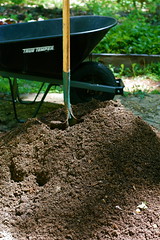 Image by Chiot's Run via FlickrYou will know the right time to harvest the compost when you no longer recognize the original materials that you used to make the pile. The finished compost should look more soil-like or humus-like. It is dark, loose and smells earthy. When you harvest the compost from your pile, if it seems too damp to spread well it would be best to spread it out a little first and expose it to the air. This will further dry the compost and will make it easier to use.
Image by Chiot's Run via FlickrYou will know the right time to harvest the compost when you no longer recognize the original materials that you used to make the pile. The finished compost should look more soil-like or humus-like. It is dark, loose and smells earthy. When you harvest the compost from your pile, if it seems too damp to spread well it would be best to spread it out a little first and expose it to the air. This will further dry the compost and will make it easier to use.If you find some bigger chunks still not fully decomposed, throw them back to the next compost pile you’re going to make. One way to get the not fully decomposed material is to use a screen or wire mesh large enough to let the compost through but small enough to screen the remaining big chunks. (Or you can just rake them out, or pick them out by hand if there aren't that many.)
As you probably know by know, compost has a lot of benefits for gardeners. For starters, compost helps improve the overall soil structure. This means the density and porosity of the soil is improved, allowing plants’ roots to grab ahold of the soil better. Deeper penetration of roots means the soil also becomes more resistant to erosion and runoff. Likewise, adding compost to the soil allows better water retention.
Aside from the soil structure, the macro and micronutrients in compost contains provide plants with the needed minerals and nutrients to grow large and healthy. The soil holds in the nutrients better when compost is added to the soil. Not to mention, compost improves and stabilizes the soil’s acidity levels as well. These are but a few reasons why compost should be used by gardeners.
Let’s go back to your newly harvested compost. After removing the pieces that did not fully decompose and after curing the finished compost, the next steps would be using what you have been brewing these past few months.
Among the most common usages of compost is as soil amendment. This simply means you add the compost to your soil and to replenish the nutrients and other essential minerals for your plants to absorb. You can also spread the compost over the soil before the planting season.
 Image via WikipediaAnother usage of compost is as potting mix. Mix the compost with sand and soil and voila! You’ll have a great quality potting mix which you can use for your plants. A mix of 1 part sand, 2 parts compost, and 1 to 2 parts soil seems to be the general agreement for using compost as potting mix.
Image via WikipediaAnother usage of compost is as potting mix. Mix the compost with sand and soil and voila! You’ll have a great quality potting mix which you can use for your plants. A mix of 1 part sand, 2 parts compost, and 1 to 2 parts soil seems to be the general agreement for using compost as potting mix.You can also use your compost as mulch (also called "top-dressing" when used in this way). Mulch is a protective layer spread over the soil to help counter the effects of the climate. You might need an ample supply of compost if you use it as mulch though. To use it as mulch, you need two to six inches of compost covering the soil surfaces around plants, trees, shrubs, and exposed slopes. As mulch, the compost will help lessen weed growth, prevent erosion, attract earthworms, and help retain water.
Getting the most out of your compost is important. You worked hard creating your compost and now is the time to reap the benefits!

No comments:
Post a Comment